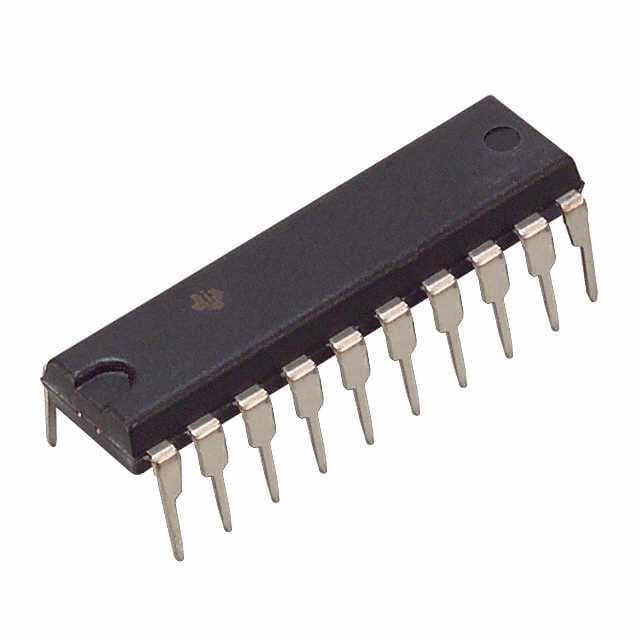TLC1541IN
Product Overview
Category
TLC1541IN belongs to the category of analog-to-digital converters (ADCs).
Use
It is primarily used for converting analog signals into digital data.
Characteristics
- High resolution: TLC1541IN offers a resolution of 10 bits, ensuring accurate conversion of analog signals.
- Low power consumption: It operates on low power, making it suitable for battery-powered devices.
- Wide voltage range: The ADC can handle input voltages ranging from 0V to Vref, providing flexibility in various applications.
- Fast conversion speed: TLC1541IN has a fast conversion rate, enabling real-time data acquisition.
Package and Quantity
The TLC1541IN comes in a standard DIP (Dual Inline Package) with 16 pins. It is typically sold in packs of 10 units.
Specifications
- Resolution: 10 bits
- Input Voltage Range: 0V to Vref
- Conversion Speed: Up to 100,000 samples per second
- Power Supply: 5V DC
- Operating Temperature Range: -40°C to +85°C
Pin Configuration
The TLC1541IN has 16 pins arranged as follows:
```
| | | 1 2 3 | |_____________| | | | 4 5 6 | |_____________| | | | 7 8 9 | |_____________| | | | 10 11 12 | |_____________| ```
Pin Description: 1. Vref: Reference voltage input 2. AGND: Analog ground 3. REFOUT: Reference voltage output 4. AIN0: Analog input channel 0 5. AIN1: Analog input channel 1 6. AIN2: Analog input channel 2 7. AIN3: Analog input channel 3 8. AIN4: Analog input channel 4 9. AIN5: Analog input channel 5 10. AIN6: Analog input channel 6 11. AIN7: Analog input channel 7 12. CS: Chip select input
Functional Features
- High-resolution conversion: TLC1541IN provides accurate conversion of analog signals into digital data with a resolution of 10 bits.
- Serial interface: It supports a serial communication interface, allowing easy integration with microcontrollers and other digital systems.
- Internal voltage reference: The ADC includes an internal voltage reference, eliminating the need for an external reference source.
- Low power consumption: TLC1541IN operates on low power, making it suitable for battery-powered applications.
- Programmable gain amplifier: It features a programmable gain amplifier that allows amplification of weak analog signals.
Advantages and Disadvantages
Advantages
- High resolution ensures precise conversion of analog signals.
- Low power consumption makes it suitable for portable devices.
- Wide voltage range accommodates various input signal levels.
- Fast conversion speed enables real-time data acquisition.
- Integrated voltage reference simplifies circuit design.
Disadvantages
- Limited number of analog input channels (up to 8).
- Requires an external microcontroller or digital system for data processing.
Working Principles
TLC1541IN utilizes successive approximation technique for analog-to-digital conversion. When a conversion is initiated, the ADC samples the analog input voltage and compares it to an internal reference voltage. By successively adjusting the digital code, the ADC converges towards the input voltage value. Once the conversion is complete, the digital output code represents the converted analog value.
Application Field Plans
TLC1541IN finds applications in various fields, including: - Industrial automation: Used for monitoring and control systems. - Medical devices: Enables accurate measurement of physiological signals. - Data acquisition systems: Converts analog sensor data into digital format. - Audio equipment: Provides analog-to-digital conversion for audio signals. - Instrumentation: Used in test and measurement equipment.
Alternative Models
Some alternative models to TLC1541IN include: - ADC0804: 8-bit analog-to-digital converter with similar features. - MCP3008: 10-bit ADC with SPI interface and multiple input channels. - ADS1115: 16-bit ADC with I2C interface and programmable gain amplifier.
These alternative models offer different specifications and interfaces, providing options based on specific application requirements.
Word count: 550 words
Senaraikan 10 soalan dan jawapan biasa yang berkaitan dengan aplikasi TLC1541IN dalam penyelesaian teknikal
Sure! Here are 10 common questions and answers related to the application of TLC1541IN in technical solutions:
Q1: What is TLC1541IN? A1: TLC1541IN is a 10-bit analog-to-digital converter (ADC) integrated circuit commonly used in various electronic applications.
Q2: What is the operating voltage range of TLC1541IN? A2: The operating voltage range of TLC1541IN is typically between 4.5V and 6V.
Q3: What is the maximum sampling rate of TLC1541IN? A3: The maximum sampling rate of TLC1541IN is 100 kilosamples per second (ksps).
Q4: How many analog input channels does TLC1541IN have? A4: TLC1541IN has 11 analog input channels, allowing for the conversion of multiple analog signals.
Q5: What is the resolution of TLC1541IN? A5: TLC1541IN has a resolution of 10 bits, meaning it can represent analog signals with 1024 discrete levels.
Q6: Can TLC1541IN operate in both single-ended and differential mode? A6: Yes, TLC1541IN can be configured to operate in both single-ended and differential mode, depending on the application requirements.
Q7: Does TLC1541IN have an internal reference voltage? A7: No, TLC1541IN does not have an internal reference voltage. An external reference voltage must be provided for accurate conversions.
Q8: What is the typical power consumption of TLC1541IN? A8: The typical power consumption of TLC1541IN is around 15 milliwatts (mW) during normal operation.
Q9: Can TLC1541IN interface with microcontrollers or digital logic circuits? A9: Yes, TLC1541IN can easily interface with microcontrollers or digital logic circuits using standard serial communication protocols such as SPI (Serial Peripheral Interface).
Q10: What are some common applications of TLC1541IN? A10: Some common applications of TLC1541IN include data acquisition systems, industrial automation, instrumentation, audio processing, and sensor interfacing.
Please note that the answers provided here are general and may vary depending on specific datasheet specifications and application requirements.


